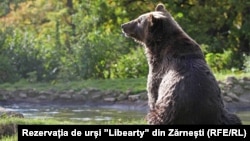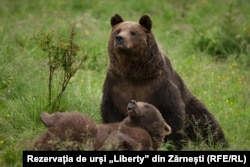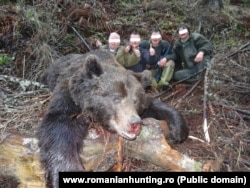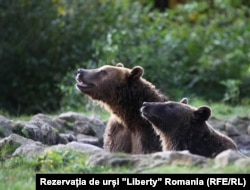Romania has the most brown bears in the European Union. But just how many bears it has depends on whom you ask, whether environmentalists, the government -- or the companies that make millions from trophy hunting.
In 2016, Romania banned the trophy hunting of large carnivores, such as bears and wolves. But under successive governments, exceptions have been granted for the sake of controlling the population. Under these guidelines, almost 1,400 bears have been killed by hunters to date, who are said to be willing to pay $15,000 for a trophy.
The official number of brown bears in Romania is over 6,000. But the government is not actually sure of the number, and environmental groups argue that it might be as low as 2,000. Hunting associations say the number could be as high as 10,000.
"Population estimates in Romania are based on traces -- that I found traces here and that means there are so many bears. Such a thing is not right," says Cristina Lapis, who manages the Libearty Bear Sanctuary, near Zarnesti in Brasov County. "The bear, as shown by serious studies, is an animal that is very active. Now you see him here; in a few hours, he's a few kilometers away. In order to know the number of bears really seriously, we should microchip them."
"Since the ban on trophy hunting, there was a push by hunters and game managers to report as many [claims] as possible," bear expert Csaba Domokos of the nature conservation NGO Milvus Group told the BBC. "There is almost no kind of management in place by authorities. We really have no idea how many bears there are."
Groups that support hunting argue that bears have attacked humans and often enter inhabited areas looking for food. There are dozens of attacks every year, and two people were killed and 50 injured in 2020, according to Romania's Environment Ministry.
"The bear population has grown a lot. It may not be good to support the hunting of these animals, but a bear is not a dog, to escape with a bite," says one man who organizes hunting parties in Prahova County. "If a bear attacks you, you will definitely be physically affected all your life."
Farmers, who also complain of losing livestock to bears, are often victims, as well as hunters, fishermen, and hikers. Last month, skiers on a lift recorded video of another skier being chased down a slope by a bear.
The appointment as environment minister in December of Barna Tanczos -- who referred to Romania as the "zoo of Europe" when he was a senator in 2015 and said 4,000 bears should be culled -- has raised fears among those opposed to bear hunting that it will only increase.
Tanczos did not respond to queries from RFE/RL's Romanian Service regarding his current opinions about bear hunting.
Agent Green, an environmental NGO, said after Tanczos' appointment: "The Environment Ministry has ended up in the hands of a hunter who dislikes bears."
Tanczos's statements "show not only that he has no idea about the critical importance of this species for the ecosystem, but he makes himself part of the problem," Gabriel Paun of Agent Green told Euronews. "Romania is not a zoo. Romania is the one country in Europe that has for ages been the best place for bears."
Hunting 'Not The Answer'
Environmentalists point out that one reason more bears are entering inhabited areas is that illegal logging in Romania is reducing and fragmenting their habitat. Forests still cover almost one-third of the country. But Romanian authorities "manage forests, including by authorizing logging, without evaluating beforehand the impacts on protected habitats" as required under EU rules, the European Commission warned recently.
Hunting is the worst solution to stop bears from endangering people, says Lapis of the Libearty Bear Sanctuary.
"There are solutions to the problem, such as those in Canada, for example. Make an orchard fence where the bear population is large -- or any barriers of any kind. Because the animals would stop at these orchards and wouldn't need to enter the community," she says. "We do not lack solutions, but the desire to apply them."
Even an aggressive bear entering an inhabited area should not necessarily be killed immediately.
"An animal that has attacked someone must be microchipped to be tracked by GPS, to be tracked where it goes. Whether it attacks or not, it can be relocated," Lapis explains. "But if he continues to be aggressive even in these conditions, then maybe hunting can be taken into account."
The bear observatory in Baile Tusnad found a way to protect bears and even make a profit: organize parties to photograph, film, or just admire the animals.
"I don't think hunting is good," says Szabolcs Mihaly, one of the two specialists behind the initiative. "Bears don't attack people. They enter cities because they know they can find food there. It is possible to make points where the bears are left food at the edge of the forest. There are solutions!"
CLARIFICATION: Romania has the largest population of bears in Europe after the European part of Russia.










